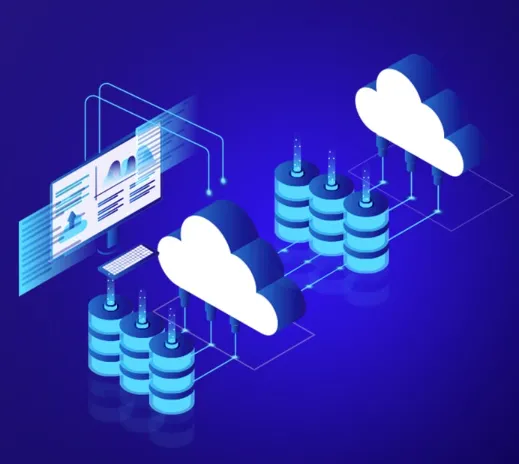Migrating your business applications and data to the cloud is a practical and scalable solution, especially for organizations dealing with overloaded networks, high costs of upgrades, and slow turnaround times. However, figuring out the best approach for the migration is key to ensuring smooth and efficient transitions. In this blog, we’ll break down the top strategies for cloud migration and explain how they can help businesses save costs, improve productivity, and boost security.
What is Cloud Migration?
Cloud migration refers to the process of moving data, applications, core systems, and infrastructure from on-premises servers to a cloud environment. This can also involve switching from one cloud provider to another.
Think of it like moving from multiple office buildings spread out across the city to a centralized building where all your data and applications are stored in one place. This shift allows employees to access what they need more efficiently, saving both time and money.
Why Cloud Migration Matters
There are several key benefits to migrating your operations to the cloud:
-
Boosted Productivity: Cloud migration provides reliable and easily accessible resources, allowing your team to accelerate software development and application design. This makes it easier to meet market demands without being bogged down by lengthy installation or development timelines.
-
Better Data Analytics: The cloud enables you to leverage your CRM systems and other databases to analyze customer data, identify opportunities, and make informed business decisions.
-
Centralized Data Access: By consolidating your data in the cloud, your team, data scientists, and engineers can collaborate more effectively, as they can access the data from anywhere at any time.
The Top 5 Cloud Migration Strategies
When transitioning from on-premises systems to cloud infrastructure, it’s essential to carefully plan and choose the right strategy to avoid redundant work and inefficient resource usage. Here are the five best strategies for cloud migration:
1. Rehost (Lift and Shift)
Rehosting involves moving your data and applications to the cloud without making significant changes. It’s often referred to as “lift and shift,” where you move your existing systems as they are from one environment to another.
-
Pros: Quick, cost-effective, and straightforward.
-
Cons: This method might miss optimization opportunities, leading to less efficient operations in the cloud.
2. Replatform
Replatforming builds on rehosting by making minimal modifications to the applications. While it still involves moving your systems, the replatforming approach allows for some improvements in architecture without a full redesign.
-
Pros: More optimized than rehosting and can provide better cloud performance.
-
Cons: Takes more time and resources than rehosting, but doesn’t fully utilize all cloud benefits.
3. Refactor
Refactoring is a more comprehensive migration strategy, involving a complete overhaul of your applications and data to take full advantage of cloud capabilities. This approach offers the best results but can be time-consuming.
-
Pros: Highly scalable, efficient, and fully cloud-optimized.
-
Cons: It can require significant downtime and may disrupt business operations during the transition.
4. Repurchase (Switch to SaaS)
Repurchasing means transitioning from legacy software to a Software-as-a-Service (SaaS) platform. This approach allows businesses to take advantage of modern cloud services without managing the infrastructure themselves.
-
Pros: Reduces the complexity of maintaining legacy systems and embraces a cloud-native approach.
-
Cons: Can be costly and requires a shift in how employees use software, which might involve a learning curve.
5. Retire
Retiring involves phasing out old applications and legacy systems that are no longer needed. This reduces costs and simplifies the cloud environment by eliminating redundant and obsolete systems.
-
Pros: Reduces operational costs and declutters your cloud environment.
-
Cons: Requires careful planning to ensure business continuity during the transition.
Creating a Smooth Cloud Migration Plan
Migrating to the cloud involves several steps, and careful planning is necessary to avoid disruptions. Here’s how to set up a successful migration:
-
Evaluate Your Current Infrastructure: Analyze your existing systems and processes to determine the best approach for your migration.
-
Choose the Right Cloud Model: Select the appropriate cloud deployment model—public, private, or hybrid—based on your business needs and the level of control you require.
-
Pick a Migration Strategy: Choosing the right migration strategy will help you avoid unnecessary delays and ensure that you optimize your new cloud environment.
-
Set a Timeline and Budget: Break the migration process into manageable stages, assign responsibilities, and allocate the necessary resources. Establish realistic timelines and budgets for each phase.
-
Test and Optimize: After migration, compare pre- and post-migration performance to ensure there’s no data loss, and make adjustments to optimize efficiency.
Why a Well-Executed Cloud Migration Strategy Matters
Properly executing a cloud migration plan offers numerous benefits for businesses:
-
Cost Savings: With cloud services, there’s no need to maintain expensive on-premises data centers. Cloud platforms often operate on a pay-as-you-go model, allowing businesses to save money on unused resources.
-
Scalability: As your business grows, you can easily scale your cloud resources to meet demand, whether you’re expanding or scaling back.
-
Enhanced Performance and Security: Cloud providers offer advanced security features, such as encryption and identity management, to protect your business from cyber threats. Additionally, the cloud allows for faster system performance with reduced downtime.
-
Faster Time-to-Market: Cloud solutions provide the tools and APIs necessary to quickly deploy and update applications, helping you respond faster to market needs.
Conclusion
Migrating to the cloud is no small task, but the benefits are clear. With the right strategy, businesses can cut costs, enhance productivity, and improve data security. Whether you choose rehosting, replatforming, refactoring, repurchasing, or retiring old systems, careful planning and execution are key to ensuring a smooth transition to the cloud.
